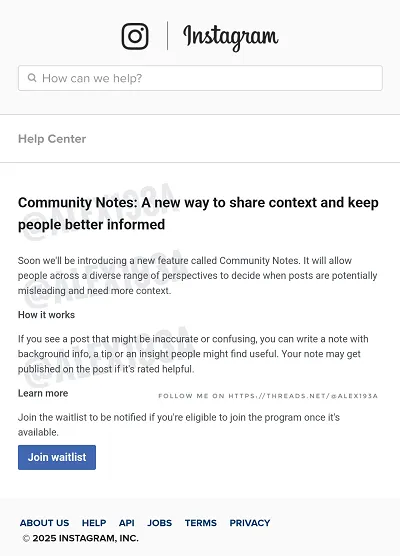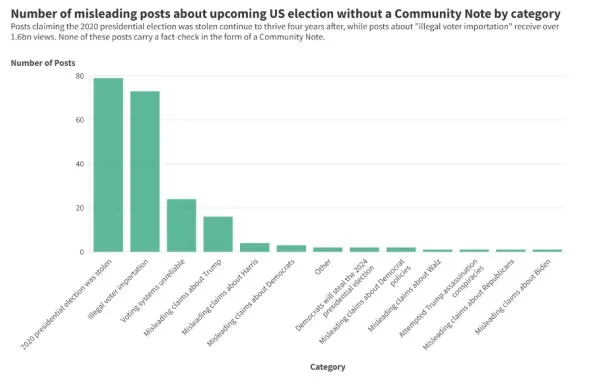Community Notes is coming to Facebook and Instagram, replacing third-party fact-checks with crowd-sourced insights into potentially misleading or false content.
And while the official roll-out of Meta’s Community Notes is still a few months away, we already have some insight into how it works, via Meta’s official announcements.
Facebook, Threads and Instagram have also all added a new overview of the option within their respective Help sites, providing more pointers on the coming functionality.

As you can see in this example, posted by app researcher Alessandro Paluzzi, Instagram’s overview of Community Notes will be linked to notes that are posted to the app.
As explained by Instagram:
“Soon we'll be introducing a new feature called Community Notes. It will allow people across a diverse range of perspectives to decide when posts are potentially misleading and need more context.
How it works
If you see a post that might be inaccurate or confusing, you can write a note with background info, a tip or an insight people might find useful. Your note may get published on the post if it's rated helpful.
Learn more
Join the waitlist to be notified if you're eligible to join the program once it's available.”
Meta’s version of Community Notes will function in the same way that notes already work on X, with a group of approved contributors empowered to review and assess suggested notes, which will then see them displayed, or not, to users.
And just like Community Notes on X, Meta’s post notes will be displayed based on contributor consensus, and importantly, will require agreement from notes contributors of opposing political perspectives to meet the threshold for display.
Which has been a key flaw of the program on X, in that people of opposing political stances are simply never going to agree on some things.

This chart displays the claims in posts that have been most commonly Community Noted on X, but those notes have not been displayed due to lack of agreement between contributors.
Unsurprisingly, research conducted by The Center for Countering Digital Hate (CCDH) found that notes on divisive political issues, like vote tampering, don’t ever reach cross-political agreement, and thus, they’re not displayed in the app.
And that actually means that the majority of political misinformation is not flagged at all via this process.
As per the CCDH:
“We found that 209 out of the 283 misleading posts in our sample [related to the U.S. election] had accurate Community Notes that are not being shown to all X users, equivalent to 74%. We rated notes as “accurate” where they align with independent fact-checks, cite reputable sources and explain why their attached post is misleading.”
So while the variable of cross-political agreement makes sense in principle, and will ensure that notes are not used as a censorship tool to combat opposing claims, there is a flaw here, which is clearly impacting the effectiveness of notes in this critical area.
That’s not to say that Community Notes is a bad option overall, as there have been various studies that also highlight the benefits, and effectiveness of the program.
Indeed, a review of 285,000 Community Notes conducted last year found that the appearance of a note on a post reduces the number of retweets by almost half, while they also increase the probability that a post is deleted by its creator by 80%. Another study found that Community Notes have helped to counter false health information in popular posts about COVID-19 vaccines.
There are clear benefits to adding crowd-sourced notes, while it also reduces the moderation burden on the platform itself. But if the previous Trump administration is anything to go by, we are going to be confronted with many more false claims over the next four years, and the fact that Meta’s building in this cross-political consensus element, while also eliminating any other form of fact checking, seems potentially problematic.
There have also been questions about the speed of Community Notes, and the effectiveness of such if they’re shown well behind time.
Most of the damage of such claims is often done early on, when a claim is re-shared and re-posted, with viral spread enabling falsehoods to be disseminated at rapid rates. Yet, that same issue is also inherent in third-party fact-checking too, as it takes time to conduct manual review of highlighted posts. So while Meta should maintain a level of rapid detection and assessment of potentially misleading claims, the speed issue is less of a factor in comparing these two approaches.
But there is a concern in relation to the broader usage of Meta’s apps, and the limits of Community Notes to be able to handle false claims adequately. X has 570 million users, and has taken around two years to build a network of over 500k Community Notes contributors.
Meta has over 3 billion users across its apps, which, by comparison, would suggest that it may need a network of around 2.5 million Community Notes contributors to make this an effective, scalable option.
That’ll take time to build, and to get good contributors up to speed, while it’ll also have to filter out bad actors who’ll look to infiltrate the Community Notes contributor network to downrank notes that don’t align with their own objectives.
Essentially, this is a massive task, and it’ll take time for Meta to implement effectively. Which is why it’s somewhat surprising that Meta’s planning to launch its version of Community Notes by March, while the noted flaws will mean that this is not a replacement for third-party fact checks for some time yet.
If ever.
Meta has repeatedly praised the effectiveness of its fact-checking process, with its own data showing that posts and articles rated as false through this system see their views reduced by over 80%. Even more, academic studies have shown that fact-checks significantly reduce false beliefs.
So while Meta’s wasting no time in implementing this new system, it does seem like we could be wading into a new, post-truth world, where the lessons of the past, that led to the implementation of fact-checks in the first place, are forgotten, and the same mistakes are repeated once again.




















 English (US) ·
English (US) ·